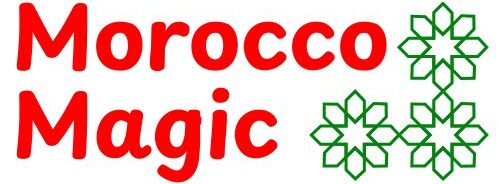🧭 About Us | Morocco Magic
Welcome to Morocco Magic—Your Gateway to the Heart of Morocco!
At Morocco Magic, we believe travel should be more than just sightseeing—it should be a journey filled with authentic experiences, unforgettable moments, and deep cultural connections.
We are a passionate team of Moroccan travel experts dedicated to helping you explore the real Morocco. Whether you’re dreaming of wandering through the colorful souks of Marrakech, riding camels across the golden Sahara dunes, or hiking in the majestic Atlas Mountains—we’re here to make it happen.
💼 What We Do:
✅ Promote the best destinations and hidden gems across Morocco
✅ Connect you directly with trusted local booking agencies
✅ Provide personalized travel tips and itinerary ideas
✅ Help travelers experience Morocco with ease, confidence, and local insight
Our goal is to bring you closer to Morocco’s soul—through its people, flavors, landscapes, and traditions.
Whether you’re planning a solo adventure, a family vacation, or a romantic getaway, Morocco Magic is your trusted guide to a trip you’ll never forget.
🌍 Let’s Create Magic Together
Ready to explore? Get in touch today, and let’s start planning your Moroccan journey!
We prioritize your data's security in our privacy policy
FAQs
Here you can get answers to your questions about traveling to Morocco
Where is Morocco?
Morocco is located in Northwest Africa, bordered by:
Algeria to the east,
Western Sahara to the south,
The Atlantic Ocean to the west,
And the Mediterranean Sea to the north.
It’s just across the Strait of Gibraltar from southern Spain, making it one of the closest African countries to Europe.
What currency is used in Morocco?
The Moroccan Dirham (MAD) is the official currency.
-
You can’t easily get dirhams outside Morocco, so exchange money upon arrival or use local ATMs.
-
Credit cards are accepted in many hotels and restaurants, but cash is essential in markets and small towns.
Do I need a visa to visit Morocco?
Most travelers (including those from the US, UK, EU, and many other countries) can enter visa-free for up to 90 days. Always check with the Moroccan consulate before your trip for the latest info.
Best places to visit in Morocco
Morocco is packed with stunning destinations, but here are the top must-visit places:
🕌 1. Marrakech
Famous for: The bustling Jemaa el-Fnaa square, colorful souks, and majestic Bahia Palace
Don’t miss: Majorelle Garden and traditional hammams
🏜️ 2. Sahara Desert (Merzouga)
Famous for: Golden sand dunes, camel rides, and overnight stays in Berber camps
Don’t miss: Sunrise over the dunes and stargazing at night
🏰 3. Fes (Fez)
Famous for: The oldest medina in the world, medieval streets, and tanneries
Don’t miss: Al Quaraouiyine University – the world’s oldest
🏞️ 4. Chefchaouen
Famous for: Its blue-painted buildings, mountain views, and peaceful vibe
Don’t miss: Ras El Maa waterfall and rooftop cafés
🏖️ 5. Essaouira
Famous for: Atlantic beaches, windsurfing, and historic sea walls
Don’t miss: Fresh seafood and Portuguese architecture
🏯 6. Casablanca
Famous for: The stunning Hassan II Mosque (one of the world’s largest)
Don’t miss: Oceanfront dining and art deco buildings
🏔️ 7. Atlas Mountains
Famous for: Trekking, Berber villages, and snow-capped peaks
Don’t miss: Hiking around Imlil or climbing Mount Toubkal
Is English widely spoken?
Not everywhere. French is more common, but in tourist areas, you’ll find people who speak basic English. Learning a few words in Darija (Moroccan Arabic) is appreciated.
How do I get around?
Taxis: Cheap, but always agree on the price first or ask for the meter
Trains: Comfortable and reliable between major cities (ONCF trains)
Buses: CTM and Supratours are the most reliable for long distances
Car rental: Available but not recommended for medina (old town) areas due to narrow streets
What should I wear?
Morocco is a Muslim-majority country, so modest clothing is recommended:
Women: Long skirts/pants, covered shoulders
Men: Avoid sleeveless shirts in rural areas
At beaches or resorts, swimwear is fine
How much money do i need to visit Morocco in 7 / 15 days
The cost of a trip to Morocco depends on your travel style (budget, mid-range, or luxury). Here’s a breakdown for both 7 days and 15 days, in USD:
✅ 1. Budget Travel (Hostels, street food, public transport)
Daily cost: $30–$50
7 days: $210–$350
15 days: $450–$750
Includes:
Dorm or cheap guesthouse
Street food or local cafés
Buses and shared taxis
Basic excursions (e.g., walking tours)
✅ 2. Mid-Range Travel (Hotels, local restaurants, guided tours)
Daily cost: $70–$120
7 days: $490–$840
15 days: $1,050–$1,800
Includes:
3-star riads/hotels
Sit-down meals at decent restaurants
Private taxis or trains
Desert tours, entrance fees, local guides
✅ 3. Luxury Travel (5-star stays, fine dining, private guides)
Daily cost: $200–$400+
7 days: $1,400–$2,800+
15 days: $3,000–$6,000+
Includes:
Luxury riads or resorts
Gourmet meals
Chauffeur-driven transport
Customized experiences (luxury desert camps, hammams)
💡 Other Costs to Consider:
Flights: $400–$900 roundtrip (from Europe or North America)
Travel insurance: ~$50–$100
Shopping & souvenirs: Flexible
Tips: Often expected for guides and drivers
Would you like a sample itinerary for either a 7-day or 15-day Morocco trip?
What's the best time to visit Morocco?
Spring (March–May) and Fall (Sept–Nov) offer ideal weather.
Summers can be extremely hot, especially inland and in the Sahara.
Winters are mild on the coast but cold in the mountains.
Can I visit mosques?
Non-Muslims are not allowed inside most mosques. The Hassan II Mosque in Casablanca is a rare exception—it’s open to tourists with guided tours.
Still have questions?
Feel free to contact us
